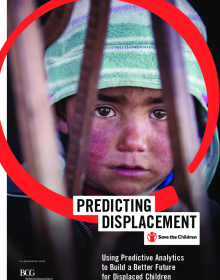
Reports
Displaced Children and Emerging Technologies: Save the Children’s opportunities for investment and impact
Publication year:
2019
English
Format:
pfg (2.1 MiB)
Publisher:
Save the Children Denmark,Save the Children International
Amongst the rising population of globally displaced – 68.6 million people in 2017 – the majority, 36 million, are children – almost twice the number we witnessed in 2005.
This crisis in displacement is occurring amidst a context of dramatic technological change across the wider aid space. Increased digital connectivity of displaced populations through mobile devices, the growing reliance on data technologies in aid programming aimed at large, mobility-affected populations, and emerging, potentially disruptive new technologies are all enabling better means for reaching and assisting these often vulnerable, hard-to-reach populations.
At the same time, the rapid introduction of technological innovations poses new ethical dilemmas, and potential threats to the safety and wellbeing of the displaced child that are not sufficiently addressed by existing practice.
Our common challenge is how to responsibly harness this transformative shift in the technological innovation ecosystem, in order to maximise the impact and efficiency of our interventions aimed at supporting displaced children.
To this end, Save the Children’s Migration and Displacement Initiative (MDI) commissioned the ‘Displaced Children and Emerging Technologies’ report, to increase our understanding of the opportunities and potential pitfalls engendered by technological change in the displacement context.
The report findings identify numerous potentially transformational and cost-effective technologies that could significantly improve our ability to access and assist vulnerable displaced populations – particularly children. The findings also provide a greater understanding of the programming challenges, child safeguarding risks and ethical dilemmas provoked by these new and often fast-changing technologies. It outlines some of the important steps Save the Children has already made to respond to these developments, but makes clear that there is a lot more we need to do. And whilst the primary focus of the report is Save the Children itself, it is apparent that many of the findings – and the recommendations – apply widely across the aid sector.
Read full abstract
Authors
View & Download
Document information
Authors
Format
pfg
Content type
Topics
Rights
© Author/Publisher
Found a mistake? Help us improve!
If you have noticed a document assigned to the wrong author or any other inaccuracies, let us know! Your feedback helps us keep our data accurate and useful for everyone.
Share
Link

